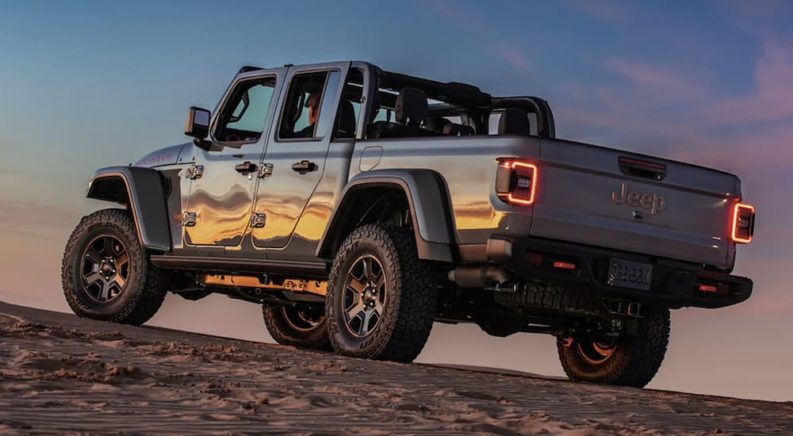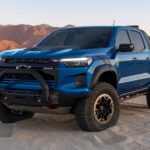Unveiled in 2019, the Jeep Gladiator pickup might seem like something of a departure for the brand. The Gladiator made waves upon its debut, turning heads with its fusion of off-road capability and classic Jeep styling with the utility of a full-bed pickup. While the model seems like a bold new step for Jeep, which has long made a name for itself by delivering some of the rugged, most capable vehicles on the market, it’s actually part of a long tradition that stretches all the way back to 1947.
Jeep might be well-known as a pioneer in the SUV segment, but few drivers realize that the automaker has introduced no less than six pickup models over its history. From the post-WWII model that took a page from its battle-tested predecessors to funky ’80s relics and the original Gladiator, we thought now would be the perfect time to look back on Jeep’s pickup past as we prepare for the launch of the new 2023 Jeep Gladiator. Adjust your seat, throw it in four-wheel drive, and follow along as we trace the history of Jeep trucks.
Willys-Overland Jeep Brand Truck: 1947-1965
Anyone familiar with Jeep history will recognize the name Willys Motors. Founded in 1908 as Willys–Overland Motors, the company was once a powerhouse in the American automotive market and, for a brief time in the early 1900s, was the country’s second-largest automaker behind only Ford Motor Company. Willys really made a name for itself in World War II when it won the contract to produce a lightweight reconnaissance car for the U.S. Army., and the Willys MB was born. The model quickly became known as the Jeep––some believe it was a phonetic pronunciation of the vehicle’s GP or “General Purpose” designation by the Army––and before the war was over, over 350,000 units had been produced. The contract was a huge boon for the company, which soon followed up its military models with a new civilian-focused version. The CJ, or “Civilian Jeep,” was a success, leading Jeep to explore lineup expansion, and the first Willys 4×4 pickup was born.
Designed with the same 118-inch wheelbase as the CJ, the one-ton Willys Jeep Brand Truck shared another crucial component with its military forerunner: the Go-Devil engine. This straight-four motor produced 55 horsepower and was notable for its heavy-duty transmission, which gave the Go-Devil a major advantage when it came to long-distance, cross-country travel. The 2.2-liter Go-Devil had proven itself time and time again on the battlefield, and its exploits were well-known to the average consumer, who were eager to leverage that same performance for everyday use. Sold from 1947 to 1965, the Jeep Brand Truck wasn’t just a pickup but was also available as a platform stake truck, chassis cab, or bare chassis. Jeep produced over 200,000 4×4 trucks over the course of the nearly two-decade run before discontinuing the model along with the CJ-3 in order to produce more CJ-5 models.
Jeep FC-150/170 Pickup: 1957-1965
The military-inspired Jeep Brand Truck found a lot of success in the domestic market, but as the industry became more competitive, Willys knew it needed to keep up with the times. This acknowledgment led to the creation of the Jeep FC or “Forward Control” series of trucks, which used a novel cab-over-engine design to save space and increase efficiency. By placing the engine beneath the cab, Jeep was able to include a longer bed without making the truck too ungainly. This approach resulted in a vehicle that had all the cargo-hauling abilities of a truck but also boasted a compact size and shorter wheelbase that allowed it to excel in off-road scenarios.
Designed by legendary automotive mind Brooks Stevens––who is also credited with creating the Jeep Wagoneer and various Harley-Davidson models––the FC-150 and FC-170 included some of the hallmarks of the classic Jeep design, such as a vertical seven-slot slot grille, but cut a decidedly more futuristic figure with its rounded cab and had a recording-breaking six-foot bed. Add to that a short turning radius and the fact that the FC could ascend grades of up to 60 percent, and you’ve got a ready-made work truck that quickly caught on with those seeking a reliable vehicle for light industrial and commercial use. The FC pickup was used as a tow, fire, and dump truck, airport service vehicle, and even a railroad crew truck capable of riding the rails.
Jeep Gladiator/J-Series Pickup: 1963-1987
Today’s Gladiator is actually inspired by an earlier Jeep pickup that was one of Willys’ last models before it changed its name to Kaiser-Jeep. The Gladiator was a pickup-based take on the Jeep Wagoneer, the iconic model that essentially created the SUV concept in one fell swoop. While maybe not as game-changing as the Wagoneer, the Gladiator also brought a number of “firsts” to the table: the first overhead cam engine in an American-made light truck with the inclusion of a 3.8-liter Tornado inline-six, the first optional automatic transmission for a four-wheel drive vehicle as well as the first power brakes and steering.
While the Gladiator enjoyed some early success out of the gate, the model was rechristened as the J-Series in 1971 when American Motors Corporation (AMC) bought out Kaiser-Jeep. AMC kept producing the J-Series until 1988 when Chrysler bought the company and phased out the Jeep pickup in favor of its own Dodge truck models. While this constant change of ownership might have affected the pickup’s production and marketing, it was also a boon in terms of power. Every time Jeep changed hands, the Gladiator saw a new engine upgrade, starting with the 112-horsepower inline-six from AMC. Later engines included a couple of V8 options, like the 5.9-liter version with 195 horsepower and 295 lb-ft of torque and even a massive 6.6-liter V8 that produced 225 horsepower and 320 lb-ft of torque.
The Jeepster Commando: 1967-1973
Offered as a convertible, roadster, and wagon in addition to its pickup guise, the Jeepster Commando is still worth a mention on the list. The Jeepster Commando was designed to compete with similar offerings like the Ford Bronco and Toyota Land Cruiser, allowing Jeep to keep up with the times as the market continued to evolve. Introduced as a replacement for the Jeep Brand Truck and FC Series pickups, the Jeepster Commando (C101) hit the road in 1967 as a compact pickup that took a number of design cues from the CJ.
Customization gave the Jeepster Commando an edge in the market, with several different models that allowed drivers to choose between open-air cruisers, hardtop hatchbacks, and more. The model was built around a 2.2-liter, four-cylinder Hurricane engine––a new take on the storied Go-Devil––and was rated at 75 horsepower. Later engines would include an optional 3.7-liter V6 with 160 horsepower and, after AMC bought the company in 1970, even a 5.0-liter V8. The later AMC model (C104) also featured refreshed design with a longer wheelbase, integrated fenders, and a new front end that featured a wider grille. The Jeepster Commando never found the success of earlier models and was discontinued after seven years and 67,500 units.
Jeep CJ-8 Scrambler: 1981-1985
The shortest-lived Jeep pickup model, the Scrambler, has become something of a collector’s item owing to the fact that only 28,000 units were produced. The pickup––which was basically a CJ-7 with a longer wheelbase, removable half-cab, and pickup box––shared the same four, six, and eight-cylinder engines as its predecessor, leveraging the popularity of the CJ-7 to a new class of drivers seeking a more practical version of the popular compact SUV. The Scrambler allowed Jeep to maintain its presence in the pickup market, which, following the discontinuation of the Jeepster Commando in 1973, was down to just the Gladiator at that point.
The Scrambler featured a distinctively ’80s design, with bold tape graphics on the fenders and side steps, as well as special wheels that set the pickup apart and gave it a more modern look. The pickup might have never gained the sort of mainstream appeal Jeep was looking for, but it counts among its adherents former President Ronald Reagan, who used one on his California ranch, and the Alaska Postal Service. Jeep designed a full-length steel hardtop version of the pickup for the State of Alaska that included right-hand drive, a hinged barn-door-style opening in the back, and an automatic transmission.
Jeep Comanche: 1986-1992
Until the revival of the Gladiator in 2019, it had been more than 25 years since the last Jeep-branded pickup rolled off the production line. That model was the Jeep Comanche, a pickup based on the Cherokee XJ compact SUV. The Comanche was notable for its hybrid design which utilized the same unibody construction approach as the Cherokee on the front but opted for body-on-frame on the back end.
The pickup provided the perfect testing ground for two new exciting technologies to emerge out of the Jeep labs: Selec-Trac and Command-Track four-wheel drive. The part-time Selec-Trac system allowed the Comanche to automatically switch from 2WD to 4WD when the environment required it, while the full-time Command-Trac was perfect for low-range 4WD applications. An optional roll bar was also offered to improve safety in dicey off-road scenarios. The Comanche was available with a number of diverse engine options, including a 2.5-liter four-cylinder, 2.8-liter V6, and 2.1-liter turbodiesel. Later additions ranged from a GM-built 4.0-liter V6 with 173 horsepower and, most notably, a 190-horsepower inline-six in 1991.
As is often the case, the end of the Comanche was a case of brand realignment. Chrysler saw the newly-acquired Jeep as its SUV arm and, wanting to leave the pickup market to its Dodge brand, ended production on the Comanche in 1992 with 190,000 produced over the course of its six-year run.
Jeep Gladiator (2020-Present)
Jeep’s latest pickup offering carries on the brand’s proud tradition of seamlessly merging utility and fun. Built on the same platform as the popular Wrangler model, the Jeep Gladiator earns high marks right out of the gate for including four-wheel drive as a standard feature. This might not be as noteworthy when compared to other popular Jeep SUV models, but within the midsize pickup category, it makes all the difference.
The Gladiator also outclasses much of the competition when it comes to power: among its top two rivals, the Toyota Tacoma and Chevy Colorado, it’s the only one to offer a V6 engine as standard. Again, no surprise when it comes to a Jeep, but it goes a long way in showcasing just how often some of these features are taken for granted among traditional pickup drivers. The Gladiator’s 3.6-liter V6 can churn out a class-leading 285 horsepower and 260 lb-ft of torque, which is more than a little notable in a category where the average hovers around 200 horsepower.
Off-road prowess has become the new watchword in the pickup category, which gives the Gladiator another major advantage over its rivals, given Jeep’s considerable off-road background. To this end, the Gladiator is the only midsize pickup to come standard with a six-speed manual transmission, giving drivers ultimate control when navigating tricky trails. Jeep has also addressed the model’s comfort and control by upping the space between the front and rear wheels by 19 inches over the Wrangler, as well as adding a full complement of off-road equipment such as skid plates, tow hooks, and an elevated air intake that gives the Gladiator the ability to ford through streams, puddles and whatever else is in your way.
While off-road performance is a nice add-on, drivers are usually drawn to the segment with more truck-like applications in mind. So how does the Gladiator hold up on that front? Jeep has made sure not to skimp on the features that often prove so important in the category, giving the pickup a towing capacity of 4,000 lbs that shoots up to 7,650 lbs with the addition of the optional tow package. This is made possible thanks to the Gladiator’s powerful 3.6-liter V6 engine. Jeep also introduced a diesel option in 2021, with a 3.0-liter EcoDiesel turbocharged V6 giving the pickup 260 horsepower and an impressive 442 lb-ft of torque.
Jeep Can Keep Up With the Big Truck Brands
While most drivers don’t think of Jeep as a traditional truck brand, a quick look at the company’s history will quickly dispel that idea. Having been at the forefront of off-road vehicle design for over 100 years, Jeep knows a thing or two about designing a rough-and-tumble model that doesn’t make excuses when the going gets tough. This comes as little surprise from the automaker that essentially created the SUV class, and it’s good to see them finally returning their attention to the pickup segment with the new Gladiator pickup. It’s another exciting entry from the company that has pushed the envelope time and time again, whether it be converting military models for civilian use, introducing the first overhead cam engine in a light truck, or taking a chance on some bold, if dated, ’80s design choices. The Gladiator might be the latest of Jeep’s pickup offerings, but if history is any indication, it definitely won’t be the last.




